Financial Management Report: Treloar Buses Pty Ltd Case Analysis
VerifiedAdded on 2022/10/15
|15
|3091
|445
Report
AI Summary
This report offers a detailed financial management analysis of Treloar Buses Pty Ltd, a case study of a bus service provider in Victoria, Australia. It begins by determining whether Treloar is a reporting entity according to SAC 1, considering factors such as employee dependence and management access to financial information. The report then explains the types of financial statements as per AASB 1053, including the income statement, position statement, statement of owner's equity, and cash flow statement, and applies these to the Treloar case. Stakeholder theory is explored, defining its meaning, identifying key stakeholders (government, customers, and investors), and analyzing how Treloar's decisions impact them. Finally, the report examines the concept of going concern, its importance, and its implications for the Fair Go Foundation (FGF), concluding that there's no significant uncertainty about FGF's ability to continue.
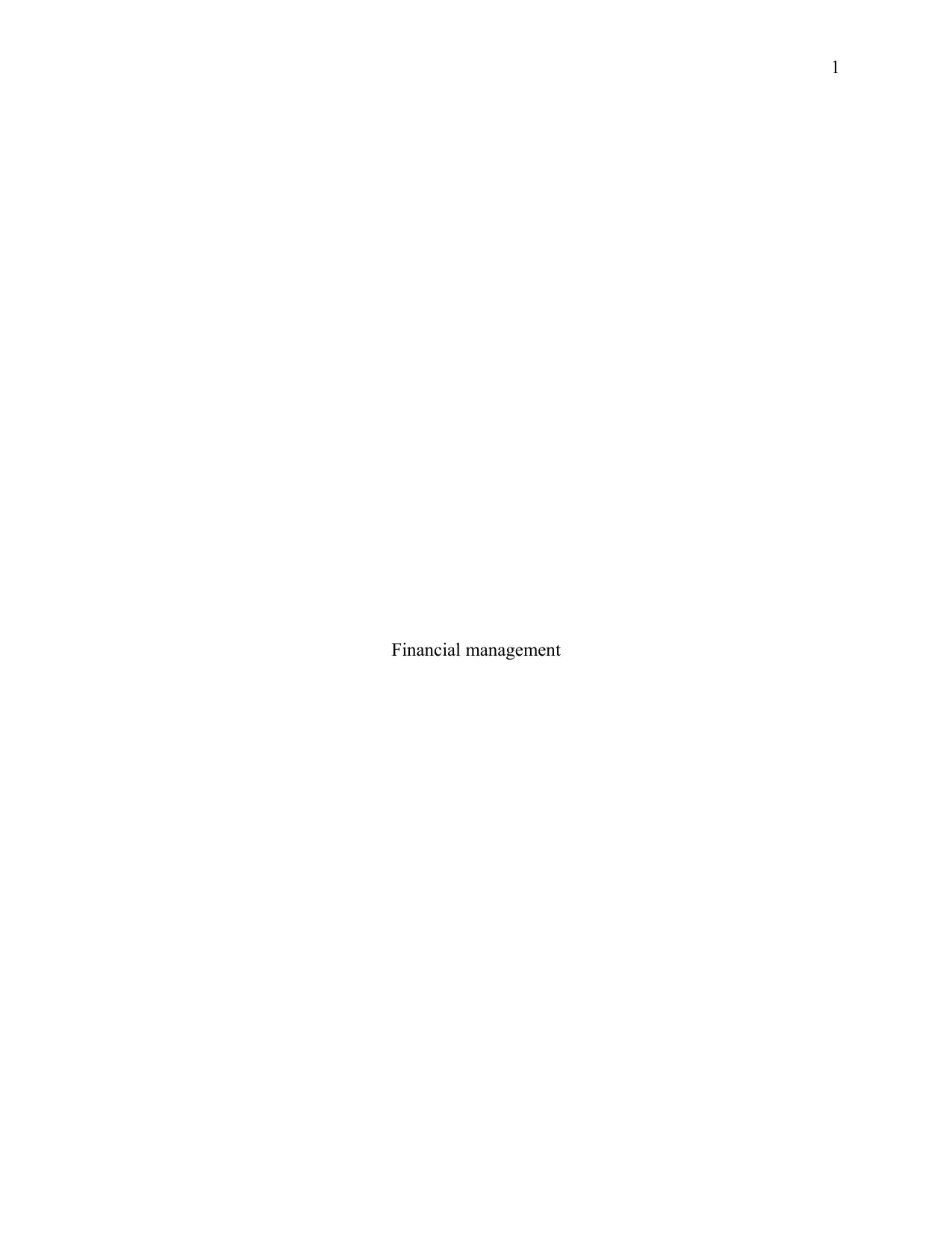
1
Financial management
Financial management
Paraphrase This Document
Need a fresh take? Get an instant paraphrase of this document with our AI Paraphraser
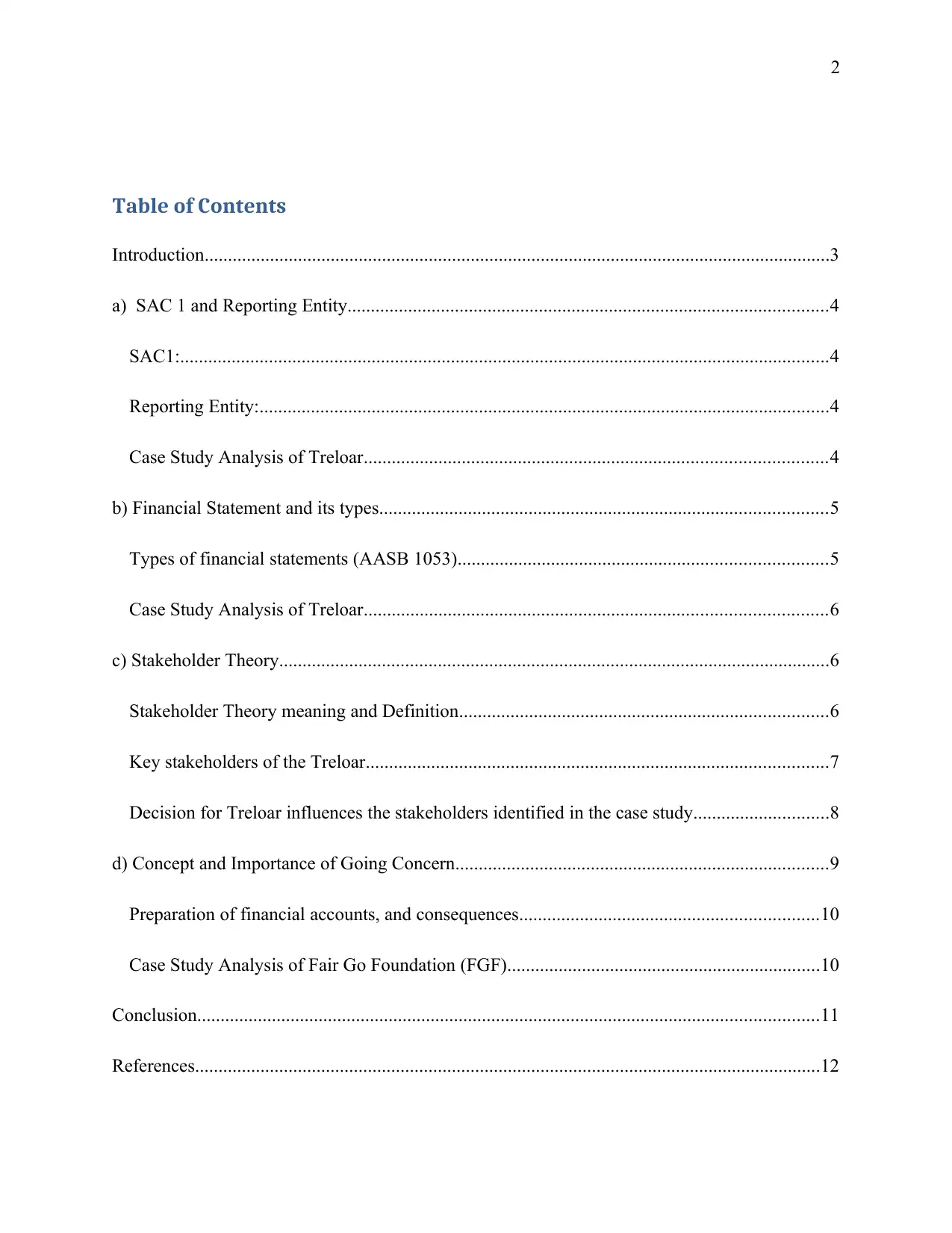
2
Table of Contents
Introduction......................................................................................................................................3
a) SAC 1 and Reporting Entity.......................................................................................................4
SAC1:...........................................................................................................................................4
Reporting Entity:..........................................................................................................................4
Case Study Analysis of Treloar...................................................................................................4
b) Financial Statement and its types................................................................................................5
Types of financial statements (AASB 1053)...............................................................................5
Case Study Analysis of Treloar...................................................................................................6
c) Stakeholder Theory......................................................................................................................6
Stakeholder Theory meaning and Definition...............................................................................6
Key stakeholders of the Treloar...................................................................................................7
Decision for Treloar influences the stakeholders identified in the case study.............................8
d) Concept and Importance of Going Concern................................................................................9
Preparation of financial accounts, and consequences................................................................10
Case Study Analysis of Fair Go Foundation (FGF)...................................................................10
Conclusion.....................................................................................................................................11
References......................................................................................................................................12
Table of Contents
Introduction......................................................................................................................................3
a) SAC 1 and Reporting Entity.......................................................................................................4
SAC1:...........................................................................................................................................4
Reporting Entity:..........................................................................................................................4
Case Study Analysis of Treloar...................................................................................................4
b) Financial Statement and its types................................................................................................5
Types of financial statements (AASB 1053)...............................................................................5
Case Study Analysis of Treloar...................................................................................................6
c) Stakeholder Theory......................................................................................................................6
Stakeholder Theory meaning and Definition...............................................................................6
Key stakeholders of the Treloar...................................................................................................7
Decision for Treloar influences the stakeholders identified in the case study.............................8
d) Concept and Importance of Going Concern................................................................................9
Preparation of financial accounts, and consequences................................................................10
Case Study Analysis of Fair Go Foundation (FGF)...................................................................10
Conclusion.....................................................................................................................................11
References......................................................................................................................................12

3
⊘ This is a preview!⊘
Do you want full access?
Subscribe today to unlock all pages.

Trusted by 1+ million students worldwide
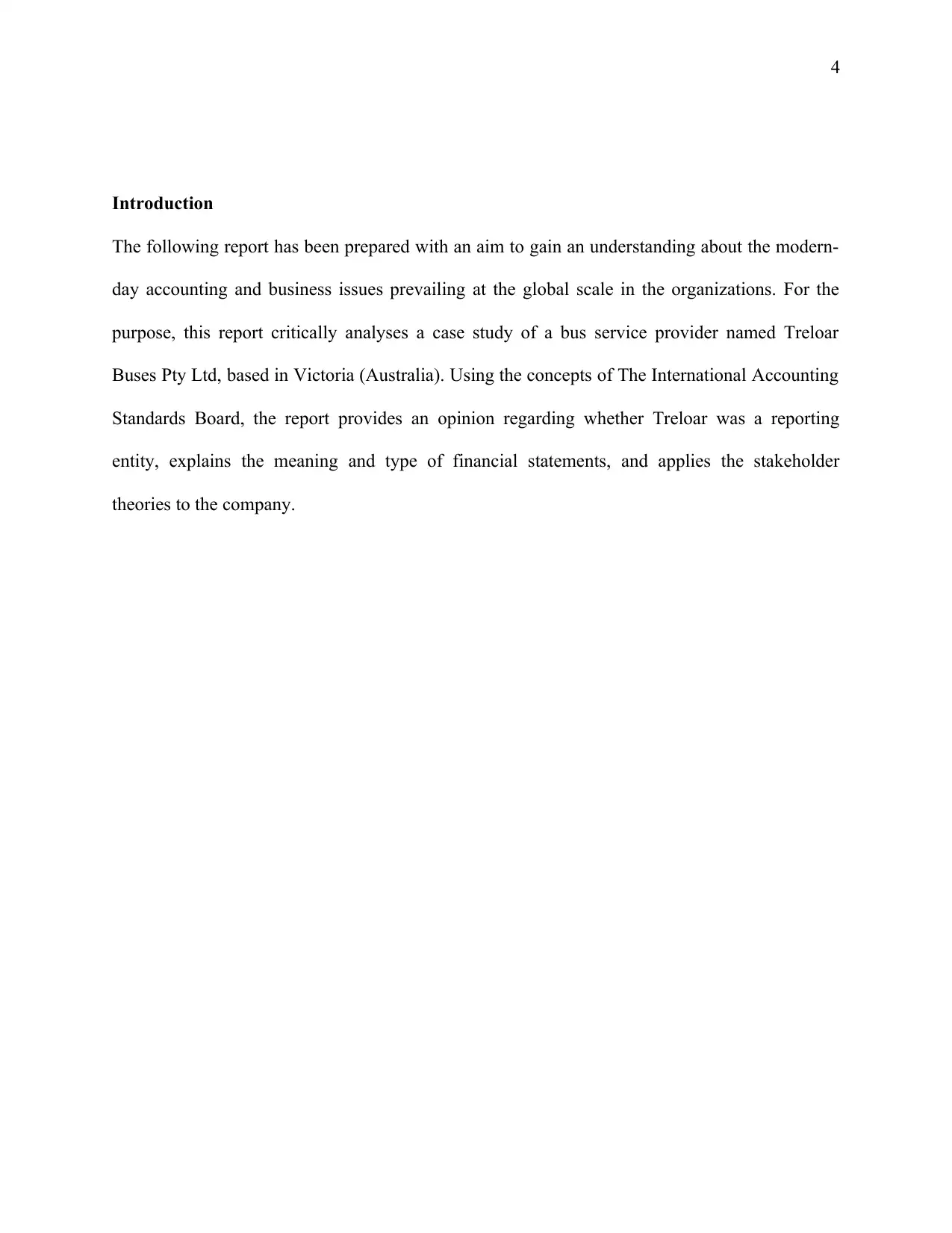
4
Introduction
The following report has been prepared with an aim to gain an understanding about the modern-
day accounting and business issues prevailing at the global scale in the organizations. For the
purpose, this report critically analyses a case study of a bus service provider named Treloar
Buses Pty Ltd, based in Victoria (Australia). Using the concepts of The International Accounting
Standards Board, the report provides an opinion regarding whether Treloar was a reporting
entity, explains the meaning and type of financial statements, and applies the stakeholder
theories to the company.
Introduction
The following report has been prepared with an aim to gain an understanding about the modern-
day accounting and business issues prevailing at the global scale in the organizations. For the
purpose, this report critically analyses a case study of a bus service provider named Treloar
Buses Pty Ltd, based in Victoria (Australia). Using the concepts of The International Accounting
Standards Board, the report provides an opinion regarding whether Treloar was a reporting
entity, explains the meaning and type of financial statements, and applies the stakeholder
theories to the company.
Paraphrase This Document
Need a fresh take? Get an instant paraphrase of this document with our AI Paraphraser
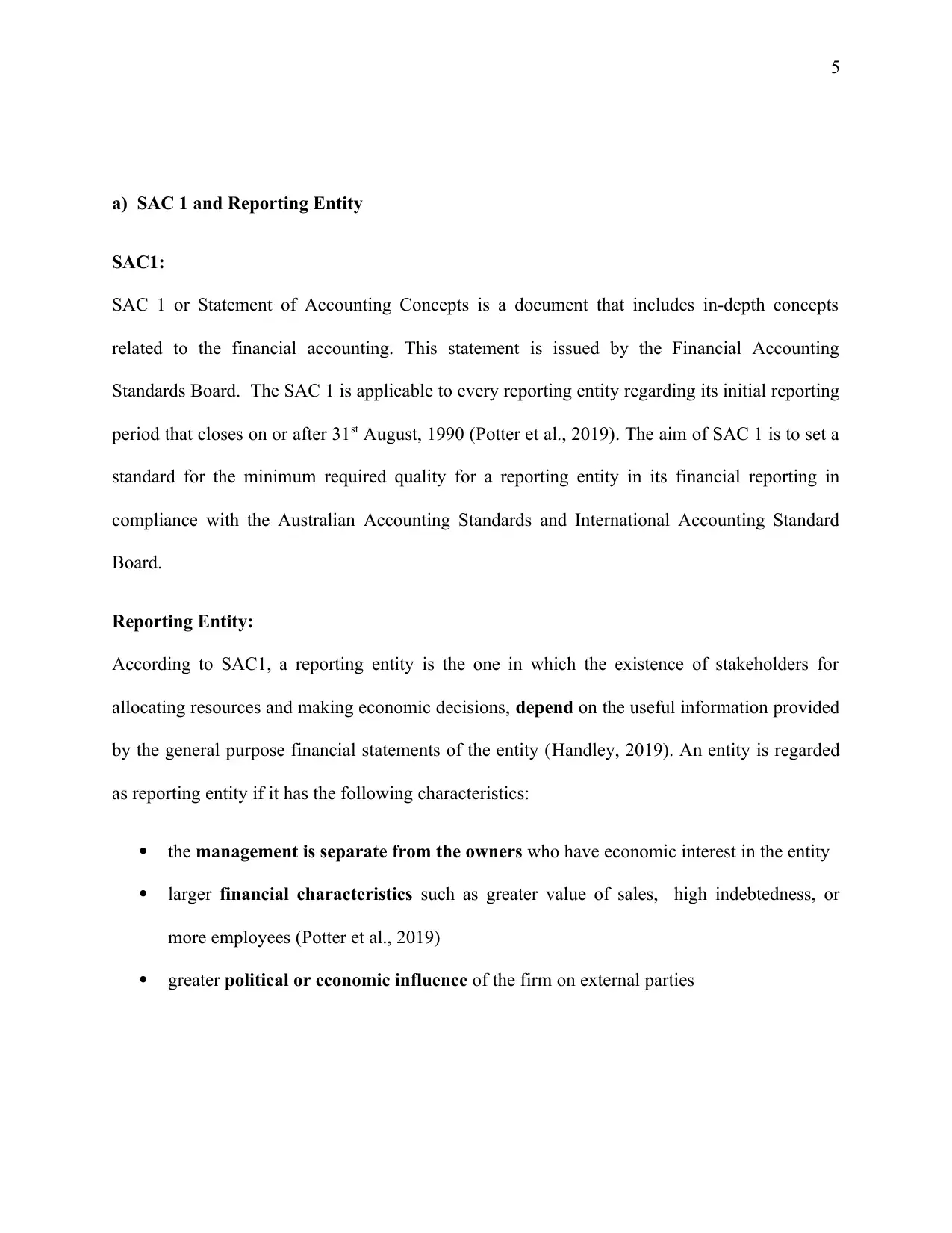
5
a) SAC 1 and Reporting Entity
SAC1:
SAC 1 or Statement of Accounting Concepts is a document that includes in-depth concepts
related to the financial accounting. This statement is issued by the Financial Accounting
Standards Board. The SAC 1 is applicable to every reporting entity regarding its initial reporting
period that closes on or after 31st August, 1990 (Potter et al., 2019). The aim of SAC 1 is to set a
standard for the minimum required quality for a reporting entity in its financial reporting in
compliance with the Australian Accounting Standards and International Accounting Standard
Board.
Reporting Entity:
According to SAC1, a reporting entity is the one in which the existence of stakeholders for
allocating resources and making economic decisions, depend on the useful information provided
by the general purpose financial statements of the entity (Handley, 2019). An entity is regarded
as reporting entity if it has the following characteristics:
the management is separate from the owners who have economic interest in the entity
larger financial characteristics such as greater value of sales, high indebtedness, or
more employees (Potter et al., 2019)
greater political or economic influence of the firm on external parties
a) SAC 1 and Reporting Entity
SAC1:
SAC 1 or Statement of Accounting Concepts is a document that includes in-depth concepts
related to the financial accounting. This statement is issued by the Financial Accounting
Standards Board. The SAC 1 is applicable to every reporting entity regarding its initial reporting
period that closes on or after 31st August, 1990 (Potter et al., 2019). The aim of SAC 1 is to set a
standard for the minimum required quality for a reporting entity in its financial reporting in
compliance with the Australian Accounting Standards and International Accounting Standard
Board.
Reporting Entity:
According to SAC1, a reporting entity is the one in which the existence of stakeholders for
allocating resources and making economic decisions, depend on the useful information provided
by the general purpose financial statements of the entity (Handley, 2019). An entity is regarded
as reporting entity if it has the following characteristics:
the management is separate from the owners who have economic interest in the entity
larger financial characteristics such as greater value of sales, high indebtedness, or
more employees (Potter et al., 2019)
greater political or economic influence of the firm on external parties
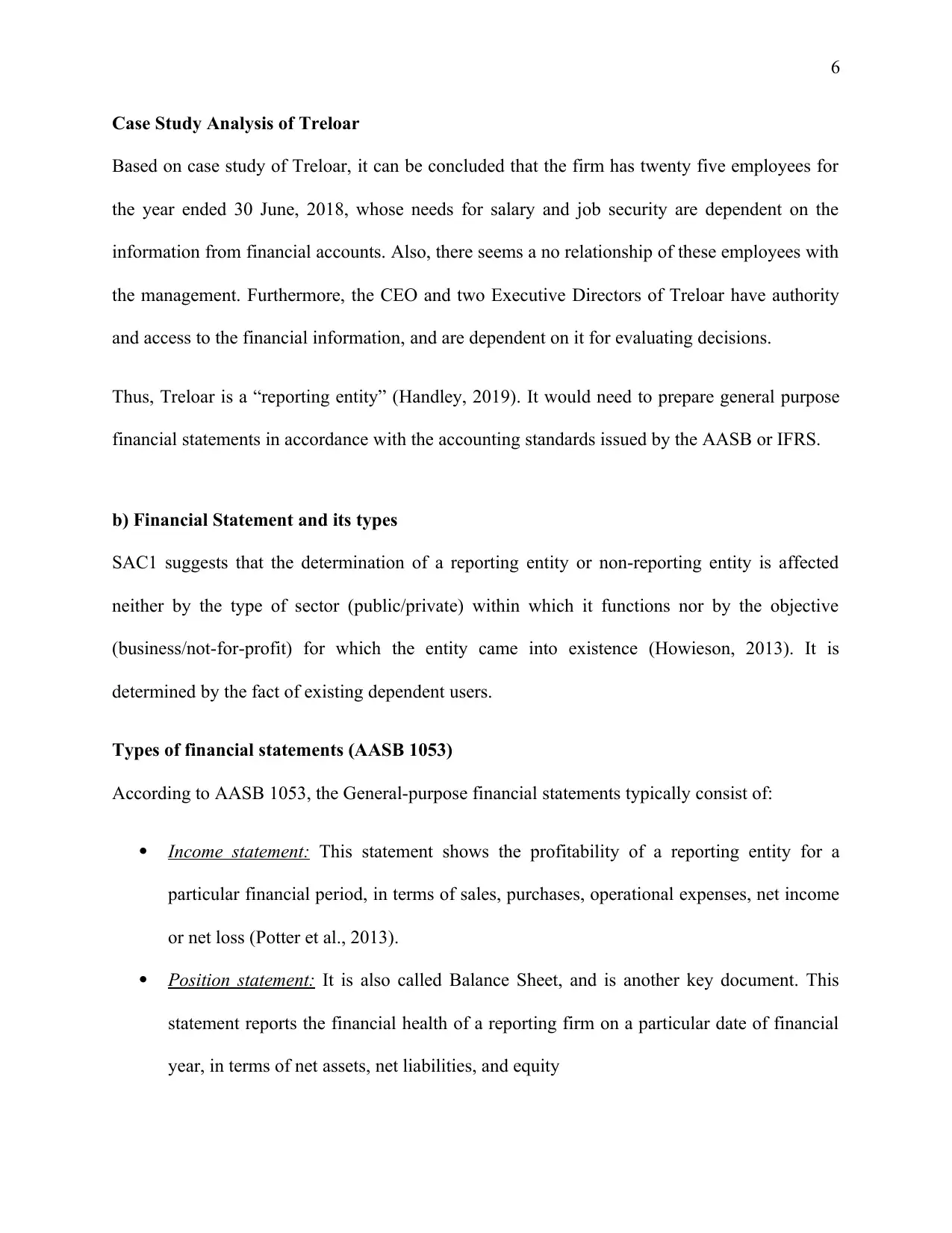
6
Case Study Analysis of Treloar
Based on case study of Treloar, it can be concluded that the firm has twenty five employees for
the year ended 30 June, 2018, whose needs for salary and job security are dependent on the
information from financial accounts. Also, there seems a no relationship of these employees with
the management. Furthermore, the CEO and two Executive Directors of Treloar have authority
and access to the financial information, and are dependent on it for evaluating decisions.
Thus, Treloar is a “reporting entity” (Handley, 2019). It would need to prepare general purpose
financial statements in accordance with the accounting standards issued by the AASB or IFRS.
b) Financial Statement and its types
SAC1 suggests that the determination of a reporting entity or non-reporting entity is affected
neither by the type of sector (public/private) within which it functions nor by the objective
(business/not-for-profit) for which the entity came into existence (Howieson, 2013). It is
determined by the fact of existing dependent users.
Types of financial statements (AASB 1053)
According to AASB 1053, the General-purpose financial statements typically consist of:
Income statement: This statement shows the profitability of a reporting entity for a
particular financial period, in terms of sales, purchases, operational expenses, net income
or net loss (Potter et al., 2013).
Position statement: It is also called Balance Sheet, and is another key document. This
statement reports the financial health of a reporting firm on a particular date of financial
year, in terms of net assets, net liabilities, and equity
Case Study Analysis of Treloar
Based on case study of Treloar, it can be concluded that the firm has twenty five employees for
the year ended 30 June, 2018, whose needs for salary and job security are dependent on the
information from financial accounts. Also, there seems a no relationship of these employees with
the management. Furthermore, the CEO and two Executive Directors of Treloar have authority
and access to the financial information, and are dependent on it for evaluating decisions.
Thus, Treloar is a “reporting entity” (Handley, 2019). It would need to prepare general purpose
financial statements in accordance with the accounting standards issued by the AASB or IFRS.
b) Financial Statement and its types
SAC1 suggests that the determination of a reporting entity or non-reporting entity is affected
neither by the type of sector (public/private) within which it functions nor by the objective
(business/not-for-profit) for which the entity came into existence (Howieson, 2013). It is
determined by the fact of existing dependent users.
Types of financial statements (AASB 1053)
According to AASB 1053, the General-purpose financial statements typically consist of:
Income statement: This statement shows the profitability of a reporting entity for a
particular financial period, in terms of sales, purchases, operational expenses, net income
or net loss (Potter et al., 2013).
Position statement: It is also called Balance Sheet, and is another key document. This
statement reports the financial health of a reporting firm on a particular date of financial
year, in terms of net assets, net liabilities, and equity
⊘ This is a preview!⊘
Do you want full access?
Subscribe today to unlock all pages.

Trusted by 1+ million students worldwide
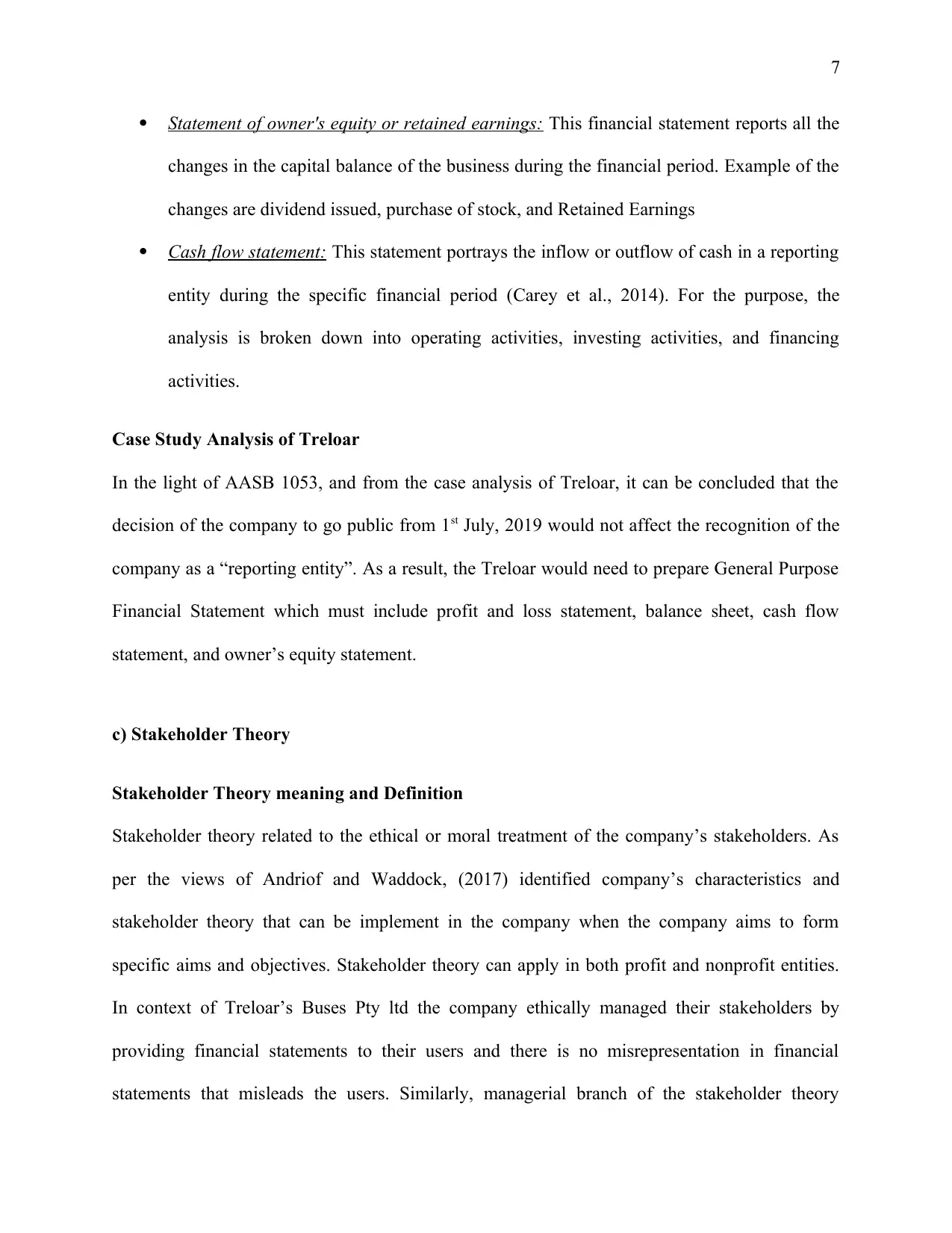
7
Statement of owner's equity or retained earnings: This financial statement reports all the
changes in the capital balance of the business during the financial period. Example of the
changes are dividend issued, purchase of stock, and Retained Earnings
Cash flow statement: This statement portrays the inflow or outflow of cash in a reporting
entity during the specific financial period (Carey et al., 2014). For the purpose, the
analysis is broken down into operating activities, investing activities, and financing
activities.
Case Study Analysis of Treloar
In the light of AASB 1053, and from the case analysis of Treloar, it can be concluded that the
decision of the company to go public from 1st July, 2019 would not affect the recognition of the
company as a “reporting entity”. As a result, the Treloar would need to prepare General Purpose
Financial Statement which must include profit and loss statement, balance sheet, cash flow
statement, and owner’s equity statement.
c) Stakeholder Theory
Stakeholder Theory meaning and Definition
Stakeholder theory related to the ethical or moral treatment of the company’s stakeholders. As
per the views of Andriof and Waddock, (2017) identified company’s characteristics and
stakeholder theory that can be implement in the company when the company aims to form
specific aims and objectives. Stakeholder theory can apply in both profit and nonprofit entities.
In context of Treloar’s Buses Pty ltd the company ethically managed their stakeholders by
providing financial statements to their users and there is no misrepresentation in financial
statements that misleads the users. Similarly, managerial branch of the stakeholder theory
Statement of owner's equity or retained earnings: This financial statement reports all the
changes in the capital balance of the business during the financial period. Example of the
changes are dividend issued, purchase of stock, and Retained Earnings
Cash flow statement: This statement portrays the inflow or outflow of cash in a reporting
entity during the specific financial period (Carey et al., 2014). For the purpose, the
analysis is broken down into operating activities, investing activities, and financing
activities.
Case Study Analysis of Treloar
In the light of AASB 1053, and from the case analysis of Treloar, it can be concluded that the
decision of the company to go public from 1st July, 2019 would not affect the recognition of the
company as a “reporting entity”. As a result, the Treloar would need to prepare General Purpose
Financial Statement which must include profit and loss statement, balance sheet, cash flow
statement, and owner’s equity statement.
c) Stakeholder Theory
Stakeholder Theory meaning and Definition
Stakeholder theory related to the ethical or moral treatment of the company’s stakeholders. As
per the views of Andriof and Waddock, (2017) identified company’s characteristics and
stakeholder theory that can be implement in the company when the company aims to form
specific aims and objectives. Stakeholder theory can apply in both profit and nonprofit entities.
In context of Treloar’s Buses Pty ltd the company ethically managed their stakeholders by
providing financial statements to their users and there is no misrepresentation in financial
statements that misleads the users. Similarly, managerial branch of the stakeholder theory
Paraphrase This Document
Need a fresh take? Get an instant paraphrase of this document with our AI Paraphraser
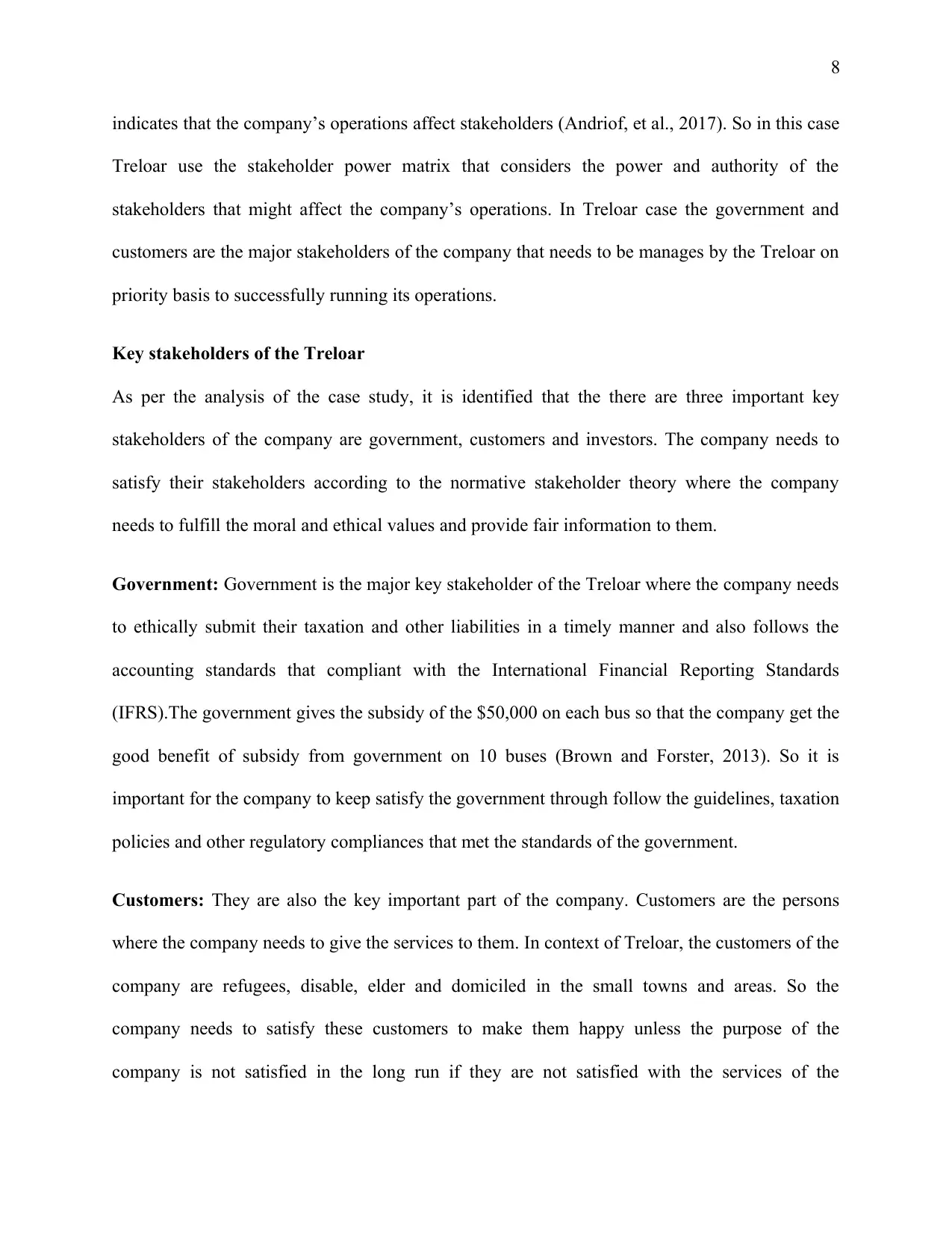
8
indicates that the company’s operations affect stakeholders (Andriof, et al., 2017). So in this case
Treloar use the stakeholder power matrix that considers the power and authority of the
stakeholders that might affect the company’s operations. In Treloar case the government and
customers are the major stakeholders of the company that needs to be manages by the Treloar on
priority basis to successfully running its operations.
Key stakeholders of the Treloar
As per the analysis of the case study, it is identified that the there are three important key
stakeholders of the company are government, customers and investors. The company needs to
satisfy their stakeholders according to the normative stakeholder theory where the company
needs to fulfill the moral and ethical values and provide fair information to them.
Government: Government is the major key stakeholder of the Treloar where the company needs
to ethically submit their taxation and other liabilities in a timely manner and also follows the
accounting standards that compliant with the International Financial Reporting Standards
(IFRS).The government gives the subsidy of the $50,000 on each bus so that the company get the
good benefit of subsidy from government on 10 buses (Brown and Forster, 2013). So it is
important for the company to keep satisfy the government through follow the guidelines, taxation
policies and other regulatory compliances that met the standards of the government.
Customers: They are also the key important part of the company. Customers are the persons
where the company needs to give the services to them. In context of Treloar, the customers of the
company are refugees, disable, elder and domiciled in the small towns and areas. So the
company needs to satisfy these customers to make them happy unless the purpose of the
company is not satisfied in the long run if they are not satisfied with the services of the
indicates that the company’s operations affect stakeholders (Andriof, et al., 2017). So in this case
Treloar use the stakeholder power matrix that considers the power and authority of the
stakeholders that might affect the company’s operations. In Treloar case the government and
customers are the major stakeholders of the company that needs to be manages by the Treloar on
priority basis to successfully running its operations.
Key stakeholders of the Treloar
As per the analysis of the case study, it is identified that the there are three important key
stakeholders of the company are government, customers and investors. The company needs to
satisfy their stakeholders according to the normative stakeholder theory where the company
needs to fulfill the moral and ethical values and provide fair information to them.
Government: Government is the major key stakeholder of the Treloar where the company needs
to ethically submit their taxation and other liabilities in a timely manner and also follows the
accounting standards that compliant with the International Financial Reporting Standards
(IFRS).The government gives the subsidy of the $50,000 on each bus so that the company get the
good benefit of subsidy from government on 10 buses (Brown and Forster, 2013). So it is
important for the company to keep satisfy the government through follow the guidelines, taxation
policies and other regulatory compliances that met the standards of the government.
Customers: They are also the key important part of the company. Customers are the persons
where the company needs to give the services to them. In context of Treloar, the customers of the
company are refugees, disable, elder and domiciled in the small towns and areas. So the
company needs to satisfy these customers to make them happy unless the purpose of the
company is not satisfied in the long run if they are not satisfied with the services of the
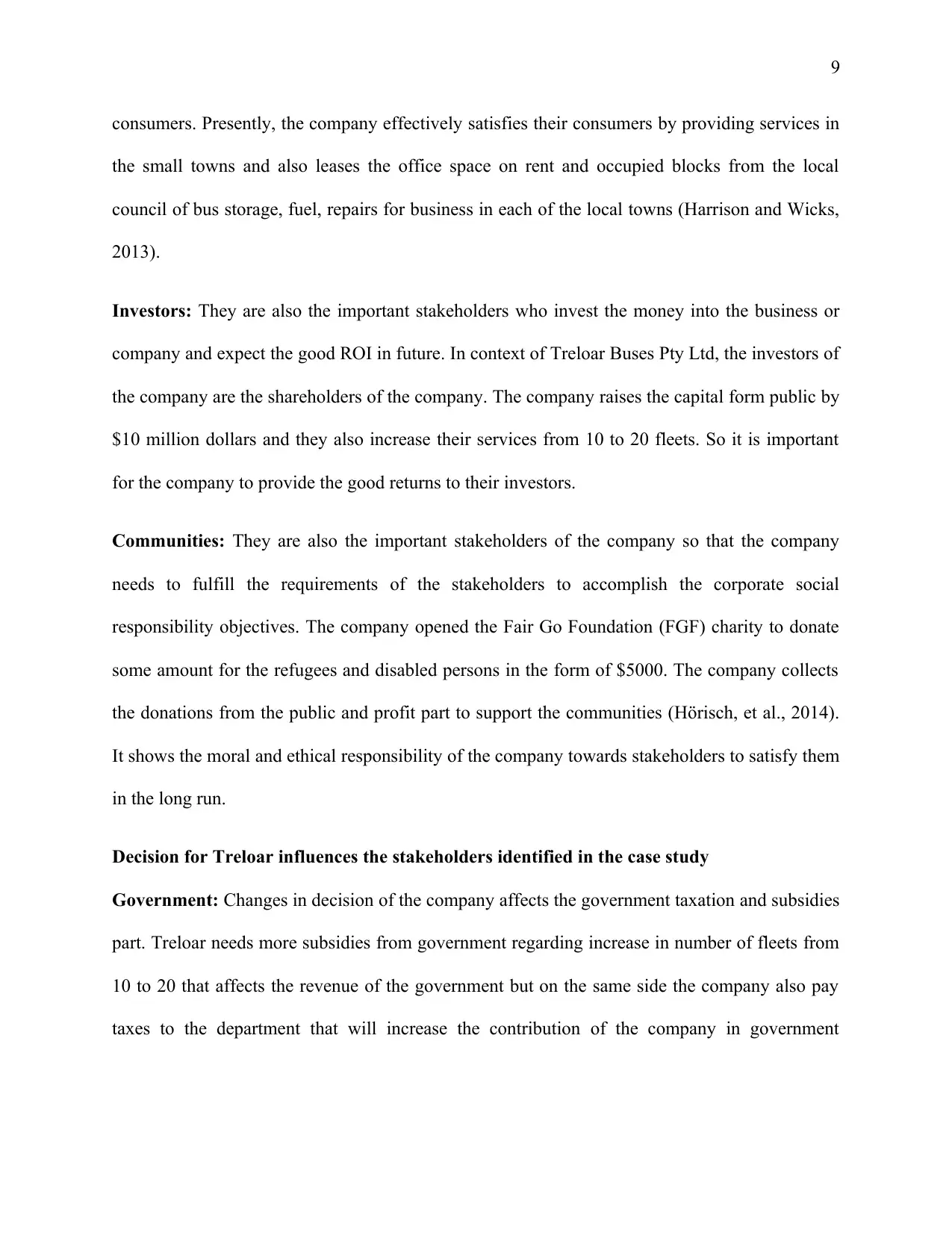
9
consumers. Presently, the company effectively satisfies their consumers by providing services in
the small towns and also leases the office space on rent and occupied blocks from the local
council of bus storage, fuel, repairs for business in each of the local towns (Harrison and Wicks,
2013).
Investors: They are also the important stakeholders who invest the money into the business or
company and expect the good ROI in future. In context of Treloar Buses Pty Ltd, the investors of
the company are the shareholders of the company. The company raises the capital form public by
$10 million dollars and they also increase their services from 10 to 20 fleets. So it is important
for the company to provide the good returns to their investors.
Communities: They are also the important stakeholders of the company so that the company
needs to fulfill the requirements of the stakeholders to accomplish the corporate social
responsibility objectives. The company opened the Fair Go Foundation (FGF) charity to donate
some amount for the refugees and disabled persons in the form of $5000. The company collects
the donations from the public and profit part to support the communities (Hörisch, et al., 2014).
It shows the moral and ethical responsibility of the company towards stakeholders to satisfy them
in the long run.
Decision for Treloar influences the stakeholders identified in the case study
Government: Changes in decision of the company affects the government taxation and subsidies
part. Treloar needs more subsidies from government regarding increase in number of fleets from
10 to 20 that affects the revenue of the government but on the same side the company also pay
taxes to the department that will increase the contribution of the company in government
consumers. Presently, the company effectively satisfies their consumers by providing services in
the small towns and also leases the office space on rent and occupied blocks from the local
council of bus storage, fuel, repairs for business in each of the local towns (Harrison and Wicks,
2013).
Investors: They are also the important stakeholders who invest the money into the business or
company and expect the good ROI in future. In context of Treloar Buses Pty Ltd, the investors of
the company are the shareholders of the company. The company raises the capital form public by
$10 million dollars and they also increase their services from 10 to 20 fleets. So it is important
for the company to provide the good returns to their investors.
Communities: They are also the important stakeholders of the company so that the company
needs to fulfill the requirements of the stakeholders to accomplish the corporate social
responsibility objectives. The company opened the Fair Go Foundation (FGF) charity to donate
some amount for the refugees and disabled persons in the form of $5000. The company collects
the donations from the public and profit part to support the communities (Hörisch, et al., 2014).
It shows the moral and ethical responsibility of the company towards stakeholders to satisfy them
in the long run.
Decision for Treloar influences the stakeholders identified in the case study
Government: Changes in decision of the company affects the government taxation and subsidies
part. Treloar needs more subsidies from government regarding increase in number of fleets from
10 to 20 that affects the revenue of the government but on the same side the company also pay
taxes to the department that will increase the contribution of the company in government
⊘ This is a preview!⊘
Do you want full access?
Subscribe today to unlock all pages.

Trusted by 1+ million students worldwide
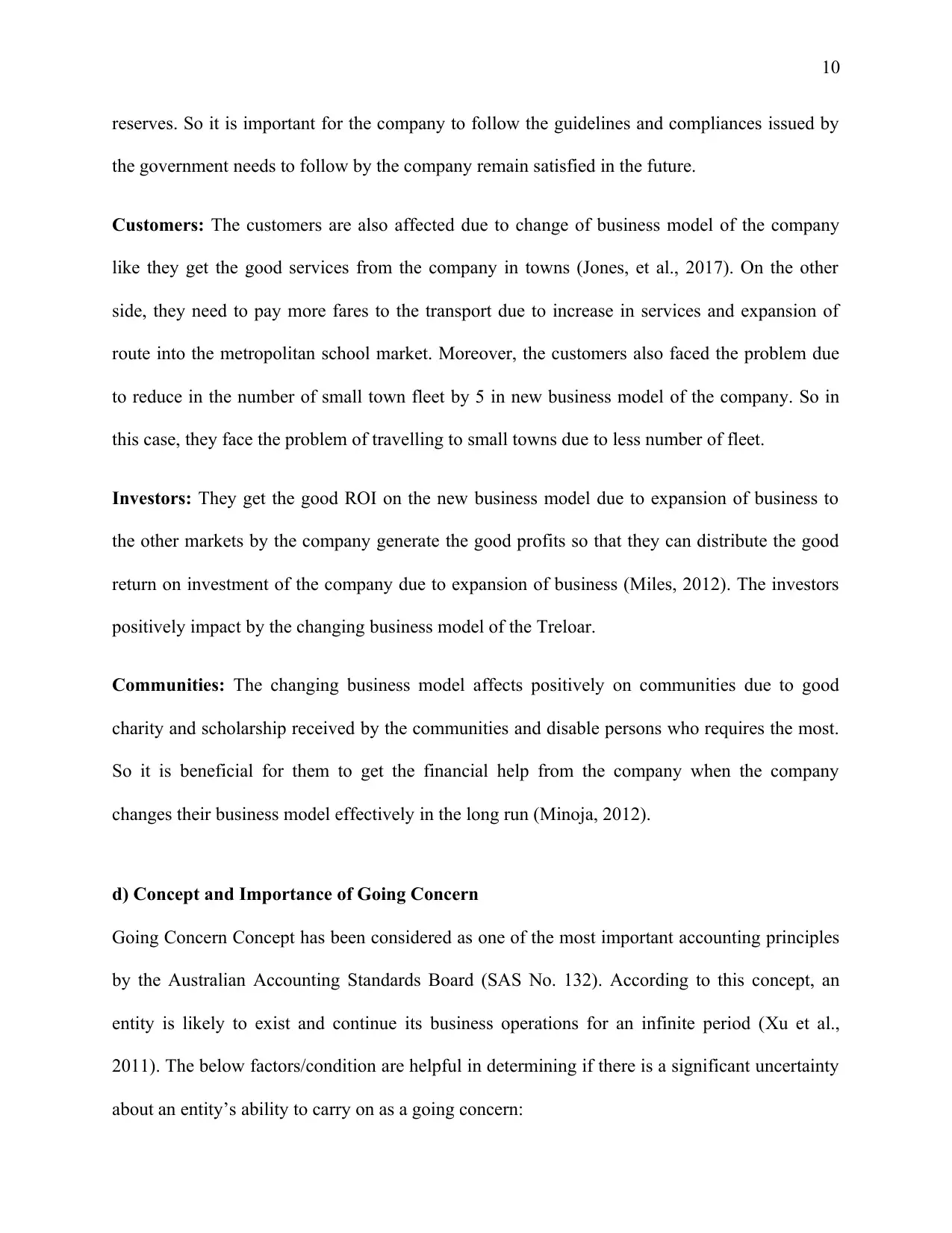
10
reserves. So it is important for the company to follow the guidelines and compliances issued by
the government needs to follow by the company remain satisfied in the future.
Customers: The customers are also affected due to change of business model of the company
like they get the good services from the company in towns (Jones, et al., 2017). On the other
side, they need to pay more fares to the transport due to increase in services and expansion of
route into the metropolitan school market. Moreover, the customers also faced the problem due
to reduce in the number of small town fleet by 5 in new business model of the company. So in
this case, they face the problem of travelling to small towns due to less number of fleet.
Investors: They get the good ROI on the new business model due to expansion of business to
the other markets by the company generate the good profits so that they can distribute the good
return on investment of the company due to expansion of business (Miles, 2012). The investors
positively impact by the changing business model of the Treloar.
Communities: The changing business model affects positively on communities due to good
charity and scholarship received by the communities and disable persons who requires the most.
So it is beneficial for them to get the financial help from the company when the company
changes their business model effectively in the long run (Minoja, 2012).
d) Concept and Importance of Going Concern
Going Concern Concept has been considered as one of the most important accounting principles
by the Australian Accounting Standards Board (SAS No. 132). According to this concept, an
entity is likely to exist and continue its business operations for an infinite period (Xu et al.,
2011). The below factors/condition are helpful in determining if there is a significant uncertainty
about an entity’s ability to carry on as a going concern:
reserves. So it is important for the company to follow the guidelines and compliances issued by
the government needs to follow by the company remain satisfied in the future.
Customers: The customers are also affected due to change of business model of the company
like they get the good services from the company in towns (Jones, et al., 2017). On the other
side, they need to pay more fares to the transport due to increase in services and expansion of
route into the metropolitan school market. Moreover, the customers also faced the problem due
to reduce in the number of small town fleet by 5 in new business model of the company. So in
this case, they face the problem of travelling to small towns due to less number of fleet.
Investors: They get the good ROI on the new business model due to expansion of business to
the other markets by the company generate the good profits so that they can distribute the good
return on investment of the company due to expansion of business (Miles, 2012). The investors
positively impact by the changing business model of the Treloar.
Communities: The changing business model affects positively on communities due to good
charity and scholarship received by the communities and disable persons who requires the most.
So it is beneficial for them to get the financial help from the company when the company
changes their business model effectively in the long run (Minoja, 2012).
d) Concept and Importance of Going Concern
Going Concern Concept has been considered as one of the most important accounting principles
by the Australian Accounting Standards Board (SAS No. 132). According to this concept, an
entity is likely to exist and continue its business operations for an infinite period (Xu et al.,
2011). The below factors/condition are helpful in determining if there is a significant uncertainty
about an entity’s ability to carry on as a going concern:
Paraphrase This Document
Need a fresh take? Get an instant paraphrase of this document with our AI Paraphraser
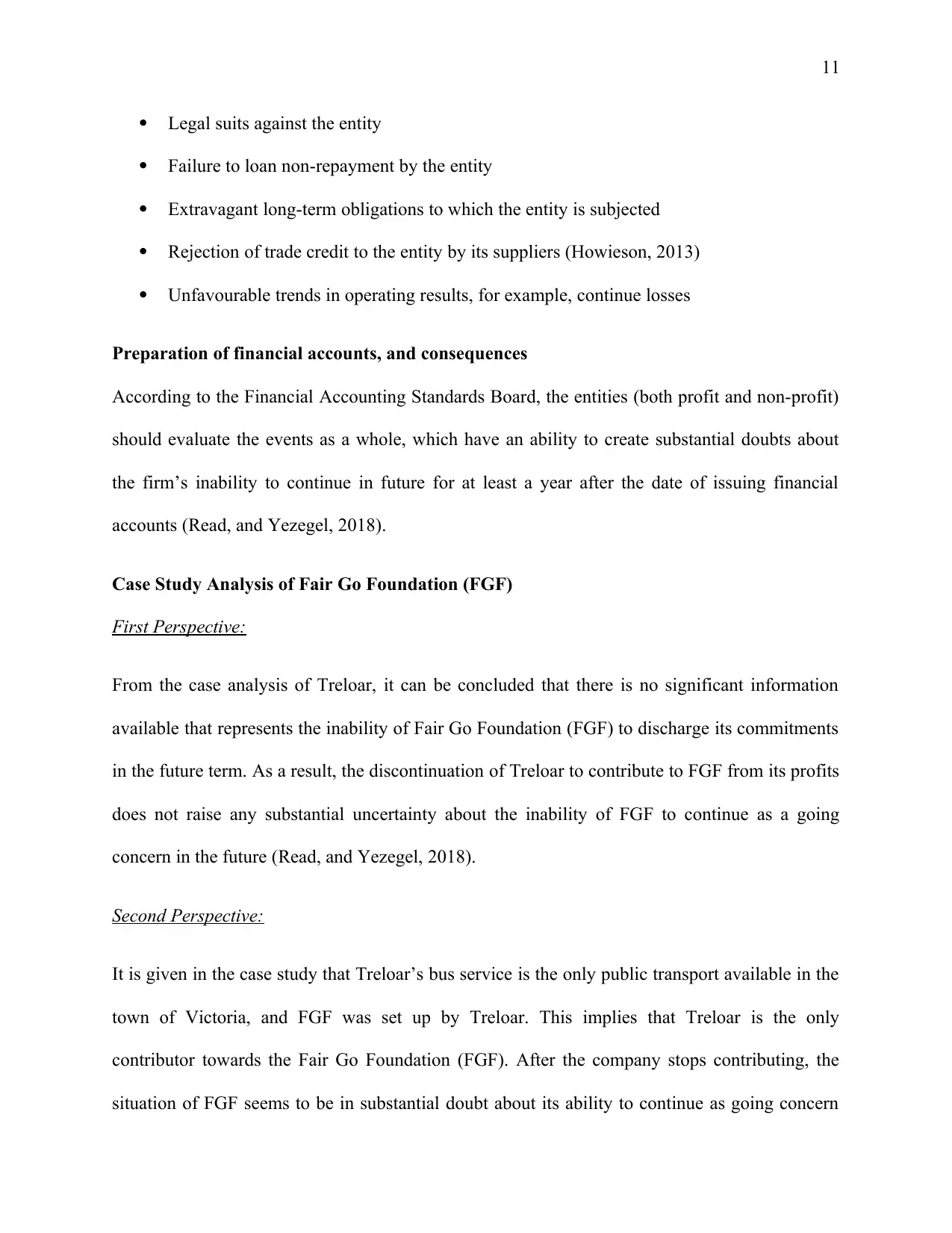
11
Legal suits against the entity
Failure to loan non-repayment by the entity
Extravagant long-term obligations to which the entity is subjected
Rejection of trade credit to the entity by its suppliers (Howieson, 2013)
Unfavourable trends in operating results, for example, continue losses
Preparation of financial accounts, and consequences
According to the Financial Accounting Standards Board, the entities (both profit and non-profit)
should evaluate the events as a whole, which have an ability to create substantial doubts about
the firm’s inability to continue in future for at least a year after the date of issuing financial
accounts (Read, and Yezegel, 2018).
Case Study Analysis of Fair Go Foundation (FGF)
First Perspective:
From the case analysis of Treloar, it can be concluded that there is no significant information
available that represents the inability of Fair Go Foundation (FGF) to discharge its commitments
in the future term. As a result, the discontinuation of Treloar to contribute to FGF from its profits
does not raise any substantial uncertainty about the inability of FGF to continue as a going
concern in the future (Read, and Yezegel, 2018).
Second Perspective:
It is given in the case study that Treloar’s bus service is the only public transport available in the
town of Victoria, and FGF was set up by Treloar. This implies that Treloar is the only
contributor towards the Fair Go Foundation (FGF). After the company stops contributing, the
situation of FGF seems to be in substantial doubt about its ability to continue as going concern
Legal suits against the entity
Failure to loan non-repayment by the entity
Extravagant long-term obligations to which the entity is subjected
Rejection of trade credit to the entity by its suppliers (Howieson, 2013)
Unfavourable trends in operating results, for example, continue losses
Preparation of financial accounts, and consequences
According to the Financial Accounting Standards Board, the entities (both profit and non-profit)
should evaluate the events as a whole, which have an ability to create substantial doubts about
the firm’s inability to continue in future for at least a year after the date of issuing financial
accounts (Read, and Yezegel, 2018).
Case Study Analysis of Fair Go Foundation (FGF)
First Perspective:
From the case analysis of Treloar, it can be concluded that there is no significant information
available that represents the inability of Fair Go Foundation (FGF) to discharge its commitments
in the future term. As a result, the discontinuation of Treloar to contribute to FGF from its profits
does not raise any substantial uncertainty about the inability of FGF to continue as a going
concern in the future (Read, and Yezegel, 2018).
Second Perspective:
It is given in the case study that Treloar’s bus service is the only public transport available in the
town of Victoria, and FGF was set up by Treloar. This implies that Treloar is the only
contributor towards the Fair Go Foundation (FGF). After the company stops contributing, the
situation of FGF seems to be in substantial doubt about its ability to continue as going concern
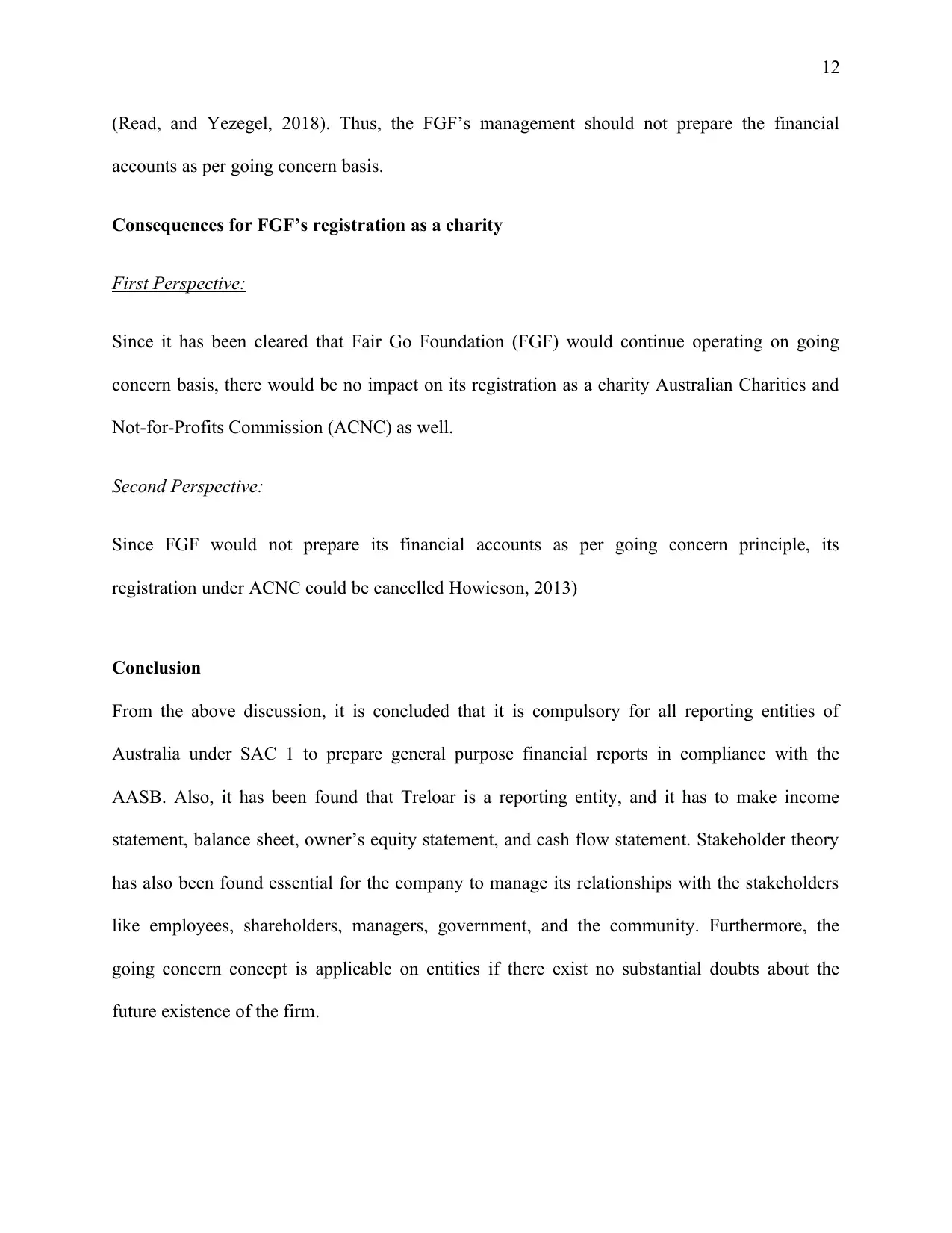
12
(Read, and Yezegel, 2018). Thus, the FGF’s management should not prepare the financial
accounts as per going concern basis.
Consequences for FGF’s registration as a charity
First Perspective:
Since it has been cleared that Fair Go Foundation (FGF) would continue operating on going
concern basis, there would be no impact on its registration as a charity Australian Charities and
Not-for-Profits Commission (ACNC) as well.
Second Perspective:
Since FGF would not prepare its financial accounts as per going concern principle, its
registration under ACNC could be cancelled Howieson, 2013)
Conclusion
From the above discussion, it is concluded that it is compulsory for all reporting entities of
Australia under SAC 1 to prepare general purpose financial reports in compliance with the
AASB. Also, it has been found that Treloar is a reporting entity, and it has to make income
statement, balance sheet, owner’s equity statement, and cash flow statement. Stakeholder theory
has also been found essential for the company to manage its relationships with the stakeholders
like employees, shareholders, managers, government, and the community. Furthermore, the
going concern concept is applicable on entities if there exist no substantial doubts about the
future existence of the firm.
(Read, and Yezegel, 2018). Thus, the FGF’s management should not prepare the financial
accounts as per going concern basis.
Consequences for FGF’s registration as a charity
First Perspective:
Since it has been cleared that Fair Go Foundation (FGF) would continue operating on going
concern basis, there would be no impact on its registration as a charity Australian Charities and
Not-for-Profits Commission (ACNC) as well.
Second Perspective:
Since FGF would not prepare its financial accounts as per going concern principle, its
registration under ACNC could be cancelled Howieson, 2013)
Conclusion
From the above discussion, it is concluded that it is compulsory for all reporting entities of
Australia under SAC 1 to prepare general purpose financial reports in compliance with the
AASB. Also, it has been found that Treloar is a reporting entity, and it has to make income
statement, balance sheet, owner’s equity statement, and cash flow statement. Stakeholder theory
has also been found essential for the company to manage its relationships with the stakeholders
like employees, shareholders, managers, government, and the community. Furthermore, the
going concern concept is applicable on entities if there exist no substantial doubts about the
future existence of the firm.
⊘ This is a preview!⊘
Do you want full access?
Subscribe today to unlock all pages.

Trusted by 1+ million students worldwide
1 out of 15
Related Documents
Your All-in-One AI-Powered Toolkit for Academic Success.
+13062052269
info@desklib.com
Available 24*7 on WhatsApp / Email
![[object Object]](/_next/static/media/star-bottom.7253800d.svg)
Unlock your academic potential
Copyright © 2020–2025 A2Z Services. All Rights Reserved. Developed and managed by ZUCOL.





